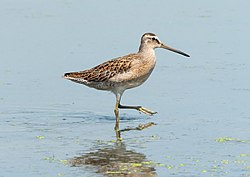| Dowitcher | |
|---|---|
 | |
| Short-billed dowitcher (Limnodromus griseus) | |
| Scientific classification | |
| Kingdom: | Animalia |
| Phylum: | Chordata |
| Class: | Aves |
| Order: | Charadriiformes |
| Family: | Scolopacidae |
| Subfamily: | Scolopacinae |
| Genus: | Limnodromus Wied-Neuwied, 1833 |
| Type species | |
| Scolopax noveboracensis [1] = Scolopax grisea Gmelin. JF, 1789 | |
| Species | |
See text. | |
The three dowitchers are medium-sized long-billed wading birds in the genus Limnodromus. The English name "dowitcher" is from Iroquois, recorded in English by the 1830s. [2]
Contents
They resemble godwits in body and bill shape, and the reddish underparts in summer, but are much shorter legged, more like snipes, to which they are more closely related. [3] All three are strongly migratory.
The two North American species are difficult to separate in most plumages, and were considered a single species for many years. The Asian bird is rare and not well known.






